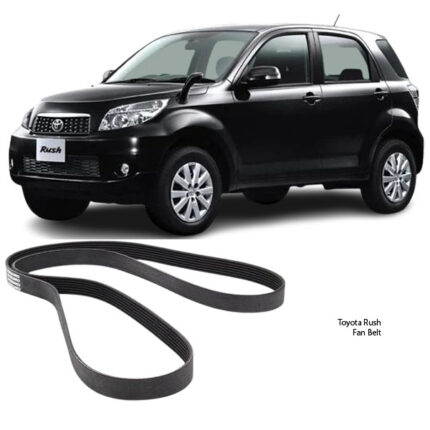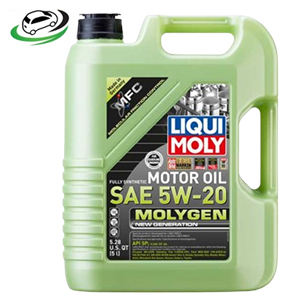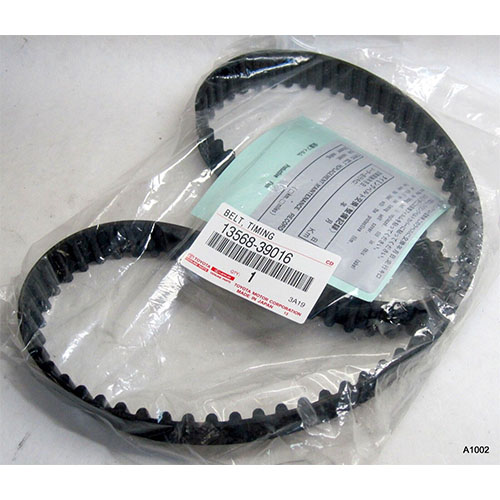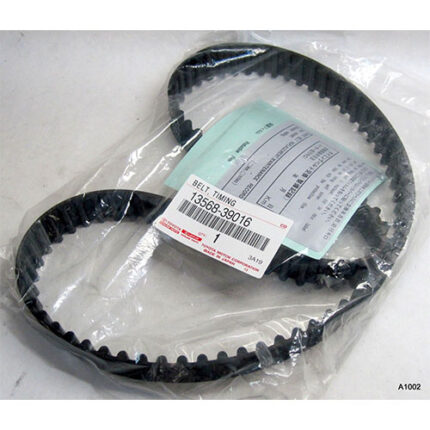-11%
Get Timing Belt Assy for 1KD/2KD Engines 13568-39016 in Kenya
The timing belt assembly is a critical component of an internal combustion engine, ensuring precise synchronization between the crankshaft and camshaft. This synchronization allows the engine’s valves to open and close at the right times during each cylinder’s intake and exhaust strokes, optimizing performance and preventing damage. Below is an in-depth exploration of its function, benefits, components, and maintenance tips.
1. Understanding the Timing Belt Assembly
The timing belt assembly comprises more than just the belt itself. It typically includes the timing belt, tensioner, and idler pulleys. Together, these components work harmoniously to maintain proper timing within the engine.
Timing Belt
The timing belt is a toothed, reinforced rubber belt that wraps around pulleys connected to the crankshaft and camshaft(s). Its teeth fit snugly into grooves on these pulleys, ensuring they rotate in unison.
Tensioner
The tensioner maintains proper tension in the timing belt. This prevents slack or excessive tightness, which could lead to belt slippage or premature wear. Tensioners can be spring-loaded, hydraulic, or manually adjustable, depending on the engine design.
Idler Pulleys
Idler pulleys guide and support the timing belt, ensuring it runs smoothly along its designated path. They help distribute load evenly, reducing wear on the belt and enhancing durability.
2. Functions of the Timing Belt Assembly
The primary function of the timing belt assembly is to synchronize the rotation of the crankshaft and camshaft(s). This synchronization ensures:
- Precise Valve Timing: Valves open and close at the exact moments needed for efficient combustion.
- Engine Efficiency: Proper timing maximizes power output and fuel efficiency.
- Prevention of Engine Damage: In interference engines, the timing belt prevents pistons and valves from colliding, which can cause severe damage.
3. Benefits of a Well-Maintained Timing Belt Assembly
Optimal Engine Performance
A correctly functioning timing belt assembly ensures that the engine runs smoothly. Proper synchronization leads to efficient combustion, resulting in consistent power delivery and responsiveness.
Enhanced Fuel Efficiency
Accurate valve timing minimizes wasted energy and fuel. This reduces emissions and saves on fuel costs over time.
Prevention of Catastrophic Failure
A damaged or broken timing belt can lead to engine failure, often requiring expensive repairs or even complete engine replacement. Regular maintenance and timely replacement of the timing belt assembly can prevent such outcomes.
Extended Engine Lifespan
By ensuring proper engine timing and avoiding undue stress on internal components, the timing belt assembly contributes to the overall longevity of the engine.
4. Signs of a Faulty Timing Belt Assembly
Recognizing early warning signs of timing belt assembly issues can prevent costly repairs:
- Ticking Noise from the Engine: A loose or damaged timing belt may create ticking sounds as it rotates.
- Engine Misfires: Improper timing can cause the engine to misfire, leading to rough idling or loss of power.
- Difficulty Starting the Engine: A worn or broken timing belt might prevent the engine from starting altogether.
- Oil Leaks: Leaks around the timing belt cover may indicate damage to the tensioner or other components.
- Visual Damage: Cracks, fraying, or glazing on the timing belt indicate wear and tear and signal the need for replacement.
5. Maintenance Tips for the Timing Belt Assembly
Proper maintenance of the timing belt assembly can save you from expensive repairs and extend the life of your engine.
Follow Manufacturer Recommendations
The replacement interval for timing belts varies by vehicle make and model. Most manufacturers recommend replacement every 60,000 to 100,000 miles. Refer to your vehicle’s manual for specific guidelines.
Inspect Regularly
Regular inspections of the timing belt and its components can help identify wear or damage early. Look for signs like cracks, fraying, or missing teeth.
Replace as a Complete Kit
When replacing the timing belt, it’s advisable to replace the entire assembly, including the tensioner and idler pulleys. These components often wear out simultaneously, and replacing them together ensures optimal performance.
Monitor Engine Oil Levels
Low or dirty engine oil can affect the timing belt assembly by causing increased friction or damage to components like the tensioner. Maintain proper oil levels and perform oil changes as recommended.
Avoid Contaminants
Ensure the timing belt assembly is protected from oil, coolant, or debris. Contaminants can degrade the belt material and reduce its lifespan.
Listen for Unusual Noises
Grinding or squealing noises could indicate issues with the timing belt, tensioner, or pulleys. Address these noises promptly to avoid further damage.
6. Timing Belt Assembly vs. Timing Chain
Some modern engines use timing chains instead of belts. While timing chains are more durable and less prone to replacement, they require adequate lubrication and can become noisy over time. Each system has its pros and cons, and the choice depends on engine design.
- Durability: Timing chains typically last longer but are heavier and noisier.
- Maintenance: Timing belts require periodic replacement, whereas timing chains need less frequent servicing.
- Cost: Timing belt replacements are usually less expensive than timing chain repairs.
7. Consequences of Neglecting the Timing Belt Assembly
Engine Damage
In interference engines, a broken timing belt can cause the pistons to collide with open valves, resulting in bent valves, damaged pistons, or even cracked cylinder heads.
Loss of Power
A failing timing belt can disrupt engine timing, leading to reduced power output and poor fuel efficiency.
Increased Repair Costs
Delaying timing belt maintenance can lead to catastrophic engine failure, requiring extensive and expensive repairs.
8. The Importance of Professional Service
Replacing a timing belt assembly is a complex process that requires specialized tools and knowledge. It involves:
- Aligning the crankshaft and camshaft to their correct positions.
- Ensuring proper tension in the new belt.
- Inspecting and replacing related components, such as water pumps, when necessary.
A professional mechanic is best equipped to handle this task, ensuring your engine remains in optimal condition.
Conclusion
The timing belt assembly is a cornerstone of engine performance, efficiency, and longevity. By synchronizing the crankshaft and camshaft, it ensures precise valve timing, prevents engine damage, and maintains smooth operation. Regular maintenance, timely replacements, and professional servicing are essential to avoid costly repairs and maximize the benefits of this critical component.
Investing in the proper care of your timing belt assembly not only protects your engine but also contributes to a safer and more reliable driving experience.
Follow us on Facebook for more parts.




